Agricultural Shows in New South Wales:
Competition, Community, Country
Have you ever experienced an agricultural show? We are sure you have at one point or another! Ever since the first show was held at Parramatta in 1823, agricultural shows have become an important social and cultural institution in the history of regional and local communities across New South Wales.
Agricultural shows are some of the most attended events across the country and have become a staple of the Australian lifestyle. They are found in all places, from rural towns to huge cities, celebrating Australian produce, practice, talent and communities.
This website is an introduction to the history of agricultural shows in New South Wales, from the early colony to the present. We hope it helps you to explore the history of agricultural shows in your local area, discover community stories, and find resources for your research.
This toggle is hidden using CSS code
Early History of Agricultural Shows
Agricultural shows were important social, cultural and economic events in New South Wales. These shows were found throughout the countryside and were associated with the early colonial agricultural societies, first established in Tasmania in January 1822 and followed by the Agricultural Society of New South Wales in July 1822. [1] These societies were based on the agricultural societies founded in Britain, which focussed on using science to create and endorse new farming techniques for the agriculture industry. [2]
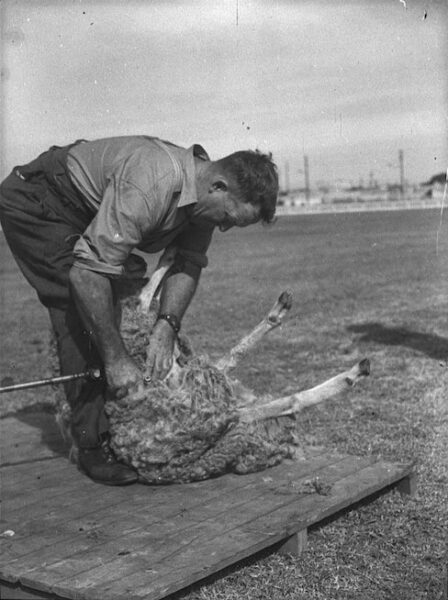
Sheep shearing, Newcastle Show, 1952. Image courtesy State Library of New South Wales.
The aims of the Agricultural Society of New South Wales were to stimulate the pastoral, agricultural, and horticultural resources of New South Wales. The Society called for: ‘action to improve breed stock and pasture grasses; husbandry through cooperative effort; the application of scientific methods; the sharing of knowledge through education; the fostering of improvement through encouragement and competition; reward for excellence’. [3] Similarly, it was also concerned with creating goods for export, such as fine wool, which was one of the early colony’s main exports. [4]
The first agricultural show in New South Wales was held at Parramatta in October 1823. The show was to be an annual exhibition of livestock and produce, along with other items that could be used to improve agriculture. [5] The Agricultural Society of New South Wales and its shows ceased between 1834-1859 due to drought and depression, but in this time other smaller societies and their associated shows emerged across New South Wales. [6] The Hunter River show started in 1844, Windsor, Penrith and the Hawkesbury region in 1845, and in 1857 the Cumberland Agricultural Society was formed, later renamed the Agricultural Society of New South Wales in 1859. [7] By 1892, there were over 90 regional agricultural societies in New South Wales, of which many had their own local shows. [8]
Aboriginal Peoples and Agricultural Shows
Australia’s Aboriginal peoples have a long and continuous connection to the land. Aboriginal spirituality, the Dreaming, taught that the land needed to be protected and cared for and intrinsically tied the land to every facet of life. [1] Country determines a person’s totem, which inherently ties them to an aspect of Country and helps to determine their roles and responsibilities in society. [2] Country therefore needed to be maintained and looked after, in line with Dreaming practices. [3] Aboriginal peoples, therefore, had important spiritual and physical practices that helped manage the land, including practices that can be best understood as agriculture. They used controlled burning of bushland and scrub to minimise the levels of fire fuel, to ensure the growth of desirable native plants, and to attract and manage food sources. [4] These practices were strictly regulated, since fire was a totem, and therefore needed to be respected in line with Dreaming practices. [5] To burn improperly or without permission was wrong. [6]
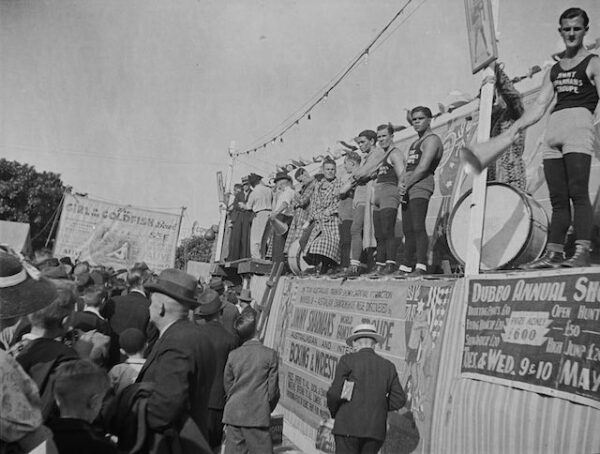
Jimmy Sharman Boxing Troupe, Royal Easter Show, Driver Avenue Moore Park, 1939. Photographer: Percy James Bryant. Image courtesy City of Sydney Archives.
As long as Aboriginal people could continue to live on Country and manage the land according to their traditional ways, disagreements with the incoming settlers were less likely, and a degree of cooperation and collaboration was possible. However, conflict ensued as more settlers occupied Aboriginal land, restricting access to important sites and waterways for their livestock. The dispossession of Aboriginal peoples forced them to live on missions or at the edges of society, while others found ways to continue living on Country by working for the cattle industry in rural Australia. In line with the nineteenth-century belief that Aboriginal people represented a ‘dying race’, it was thought by workers in the agriculture industry that Aboriginal people could spare themselves the ‘destiny of extinction’ by becoming educated in the pastoral industry and working on pastoral stations. [7] This conceit was in line with prevailing ideas that sought to force Aboriginal people to adopt settler ways. [8] Regional agricultural societies fed into this narrative, emphasising the link between agriculture and nation-building while promoting ‘social progress, national pride and imperial conquest over the Australian environment and its Indigenous peoples’. [9]
However, Indigenous people did interact with agricultural shows in a variety of different ways. From the nineteenth century, the annual Agricultural Show in Sydney, as well as other rural shows throughout New South Wales, featured ‘Aboriginal Exhibits’ where Aboriginal peoples could display and sell their goods. [10] Items commonly shown were objects made at missions throughout the colony, including implements, weapons and mats. [11] Shellwork produced by Aboriginal women was widely sold in New South Wales from the 1870s. [12] It was a popular tourist souvenir and agricultural shows were an important avenue for display. [13] Shellwork displays were also found at rural and regional agricultural shows, proving to be a widespread practice. [14] Aboriginal people also participated in competitions, sometimes winning awards in wood-chopping and buck-jumping contests. [15]
Aboriginal women and men were also prominent participants in the sideshow scene, especially during the first half of the twentieth century. [16] Perhaps the travelling lifestyle of these sideshows granted Aboriginal people more freedom and less governmental intervention in their lives. It would certainly have contrasted with control under rule of the Aborigines Protection Board. [17] Similarly, these sideshows appealed to Aboriginal people as a chance to escape the discrimination they faced on reserves and in society. [18] There is some evidence that Aboriginal women took part in some of the more risqué sideshows, such as the leg shows and strip-tease. [19] Aboriginal men were part of travelling tent-boxing troupes, which would travel from show to show up and down the coast throughout the year. [20] One of the most famous troupes was that of Jimmy Sharman, who travelled to about 100 shows in a year. [21] These boxers came from diverse backgrounds, including Aboriginal, Pacific Islander, Māori and Caucasian (white) members. The variety of their heritage, appearance and language provided a drawcard that attracted country audiences. [22]
Experiencing the Show
Royal Agricultural Society show scene, women in the foreground, [1930s] / photographed by Max Dupain. Image courtesy Mitchell Library, State Library of New South Wales.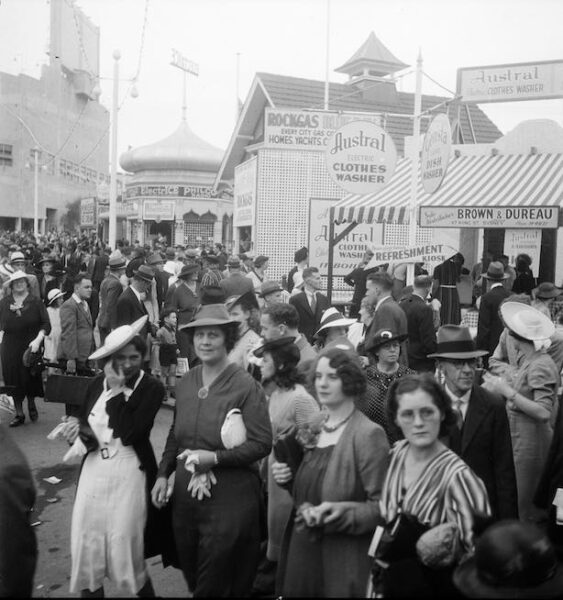
Agricultural shows were laid out in a very specific way. There was usually a central area for the livestock, commercial marquees and competitions, and a sideshow alley surrounding this, where entertainment, rides, and other forms of carnival could be found. [1]
Competition came in all shapes and sizes. There were livestock and produce competitions, domestic wares, arts and crafts, equestrian, woodchop and, in more recent times, motorsports. [2] Competitions in the early colony were an important way of raising standards and helping to stimulate improvement in agricultural practice. [3] Show traditions, such as the ‘Grand Parade’, allowed winners to be presented at the show and in the local newspaper while also gaining monetary prizes. [4] The showcasing of the best local produce, livestock and goods also helped create a form of community, especially in rural areas. [5]
Show competitions also varied between regional and city areas, with competitions such as the ‘show girl’ being found more widely at rural-based shows. [6] Modern-day competitions have changed their focus, becoming much more centred on women being district and rural ambassadors for the show and the state. [7] From the 1990s, many of the ‘Miss Showgirl’ competitions changed to ‘Rural Ambassador/Young Citizen’ competitions. Winners were now presented as representatives for their regional communities and would promote agricultural shows and industries to a broader audience. [8]
Shows were an important day out for people around the country. Agricultural shows often occurred during school holidays, allowing people in the city to come to the country. [9] Nowadays, agricultural shows run almost year-round. [10] Along with being a day of fun and community, show days are also often important days in the social calendar. For instance, the Tweed Daily called the Tweed River Agricultural Show in 1921 the ‘social event of the season.’ [11]
Another important part of the show was the entertainment. Agricultural shows have long been characterised by sideshows known as ‘sideshow alley’. Sideshows were typically run by travelling showmen and were a popular attraction at agricultural shows from the late nineteenth to the mid-twentieth century. [12] They emerged at agricultural shows as they grew in popularity amongst urban city dwellers, adding a drawcard for city-goers with little interest in produce and livestock. [13] Sideshows typically showcased people who had interesting talents or were physically or racially different, including Aboriginal people. [14] The representation of ‘difference’ was a drawcard for audiences. [15] For Aboriginal people and performers from Asia, Africa and the Pacific this lifestyle granted them more freedom of movement with less government scrutiny than what was typically allowed under the White Australia Policy and the Aborigines Protection Board. [16]
From the early twentieth century, rides and showbags became available at agricultural shows, providing another form of entertainment for children and parents alike. [17]
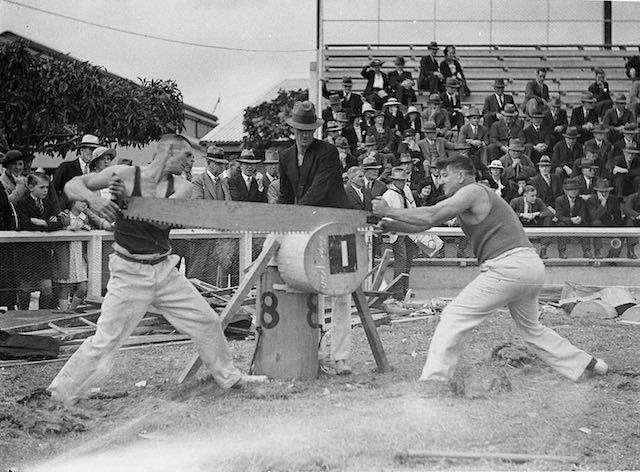
Woodchopping at the Royal Easter Show, 1938. Image Courtesy State Library of New South Wales.
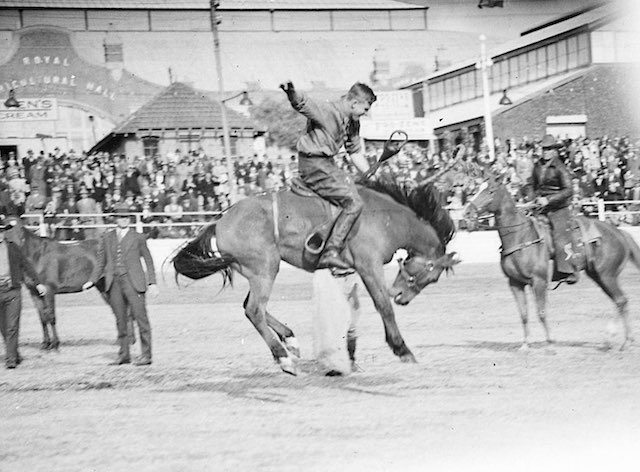
Buckjumping at the Royal Easter Show, 1941. Image Courtesy State Library of New South Wales.
Education
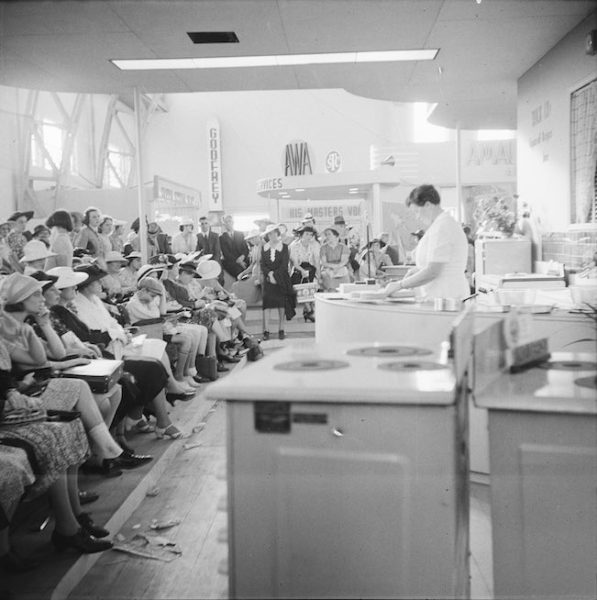
Cookery demonstration, Royal Easter Show 1940. Image courtesy Hood Collection, Mitchell Library, State Library of New South Wales.
Education for farmers, workers and the general public was one of the key functions of agricultural societies in colonial New South Wales. Before establishing the Department of Agriculture in 1890, there was no centralised way for information about agricultural practice and husbandry to spread through the colony. [1] Agricultural societies played an important role in this vacuum by distributing information to their members and the public through their lecture programs. Public lectures were based on the latest university research and covered various topics, such as crop management, animal care and disease prevention. [2]
The Agricultural Society of New South Wales’ publications also became an important way of sharing new knowledge. The first ASNSW (later RAS) journal was published in 1868 with the key aims of providing information on the proceedings of the society and educating settlers on practices that suited the Australian climate. [3] Acclimatising to Australia’s environment was especially important for the many settlers who had migrated from Britain. As was noted in the journal’s first volume, the new arrivals had ‘much to un-learn before they could succeed here.’ [4]
Agricultural societies were also important research bodies and worked to invest in and promote innovative technologies. The Royal Agricultural Society, in particular, was known for this type of work, such as the time they invested in refrigeration technology that would allow meat to be shipped from Australia to England without spoiling. [5] While this attempt was initially a failure, it provides a great example of how these societies aimed to promote innovative research and technologies.
Shows also played important roles in the education aspect of agricultural societies. They were places where members could meet to share knowledge and expertise and were important places for the promotion of the agriculture industry to the public. [6]
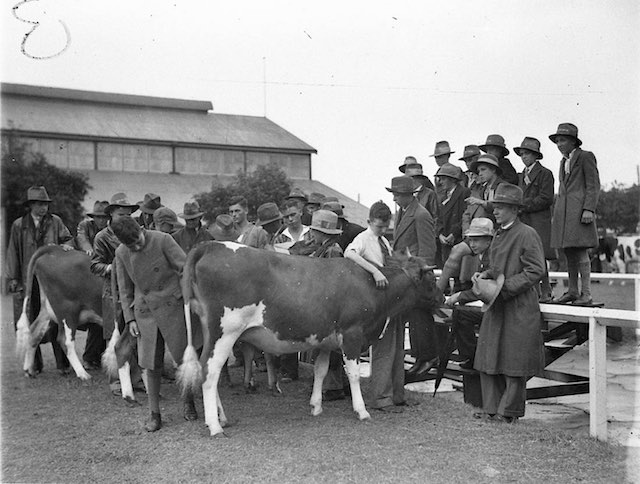
Members Of the Young Famers League try their hand at judging. Image Courtesy State Library of New South Wales.
Government and industrial agencies often used agricultural shows as venues to promote their products and policies to farmers and producers. [7] Newspapers discussed the ‘machinery section’ and shared the new forms of machinery on display. [8] Education was also provided at local shows through demonstrations and model farms. [9] Public demonstrations have been a longstanding tradition at agricultural shows, with the first occurring at Parramatta in 1823 when Edward Wollstonecraft demonstrated the use of a cultivator. [10]
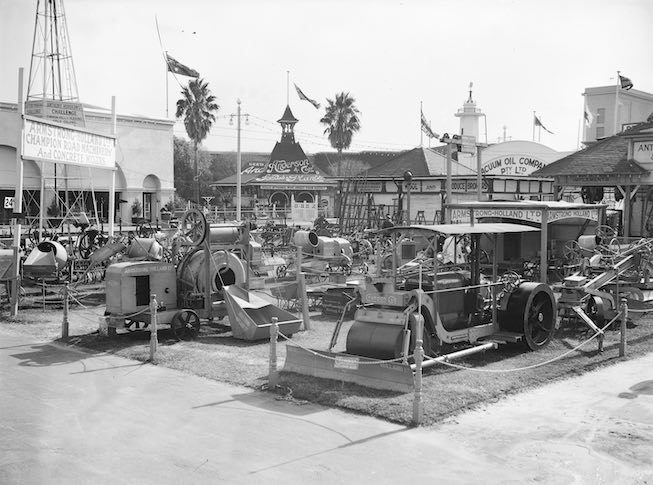
Agricultural machinery and equipment exhibition at Royal Easter Show, ca. 1931-1933. Image Courtesy Hood Collection, Mitchell Library, State Library of New South Wales.
One Show, Many Communities
People from different cultural backgrounds have left their mark on agricultural shows in many ways. Chinese market gardeners were one of the first communities recorded to participate in the show as producers and sellers.
Chinese market gardens were fruit and vegetable produce farms run by Chinese migrants and their families from the 1850s onwards. [1] In New South Wales, market gardens were commonly found near goldfields and around Chinese camps. [2] Market gardens were important staples in local communities, as they supplied a wide range of vegetables, herbs and fruits for everyday eating and medicinal purposes. [3]
Chinese market gardeners often took part in agricultural shows in regional towns. At many shows around the country, Chinese gardeners most commonly won in fruit and vegetable categories. However, they also occasionally won in flower competitions and other events. [4] In some cases, Chinese market gardeners were so successful at local shows there were calls for them to be disqualified or judged in a separate category. At a Cooma Pastoral and Agricultural Society meeting in October 1899, it was said that ‘if a Chinaman made his living by gardening he was not entitled to compete against amateurs.’ [5]
Other migrant communities had different interactions with the show. In the post-war period, new migrants from Europe brought with them a host of new skills in areas such as handmade jewellery and leatherworking, which led to the creation of new prize categories at the Royal Easter Show in 1952. [6] Along with new categories for arts and crafts, categories for European produce, continental cooking, and confectionery manufacture were also added. [7] Records indicate that Europeans also won at shows, with Dutch competitors winning in the animal and rural product promotion categories in 1985. [8]
Agricultural shows were also an opportunity to promote Australia to those overseas and other migrants in Australia. ‘The Italian Journal,’ Il Giornale Italiano, which was published in Sydney but was written in Italian, included information on the types of machinery and demonstrations that occurred at the Easter Show in a way that could be easily understandable to migrant communities. [9] Internationally, the show was an avenue for advertising, with a film about the Kiama Agricultural Show being distributed throughout the Netherlands in 1952 to help attract Dutch migrants. [10]
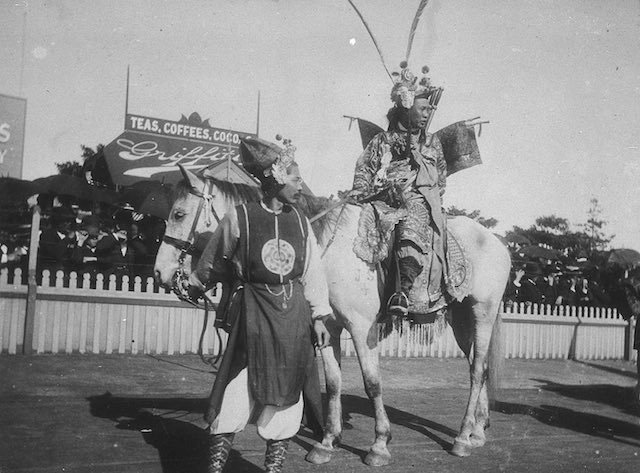
Chinese procession at Sports Agriculture Grounds – Sydney, NSW, 1897. Image Courtesy Mitchell Library, State Library of New South Wales.
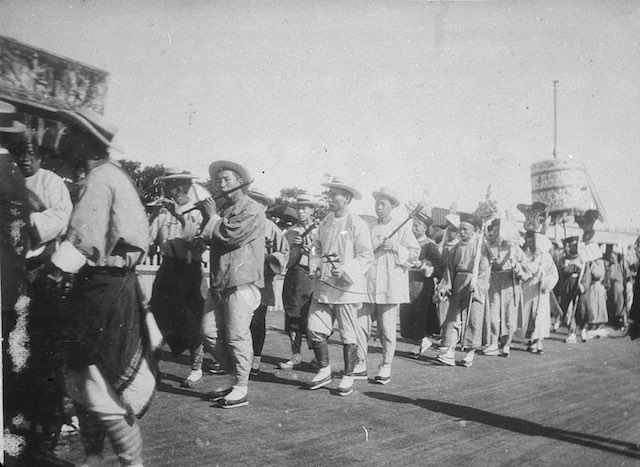
Chinese procession at Sports Agriculture Grounds – Sydney, NSW, 1897. Image Courtesy Mitchell Library, State Library of New South Wales.
References
Early History of Agricultural Shows
[1] The Royal Agricultural Society of Tasmania, We Are RAST, The Royal Agricultural Society of Tasmania, <https://www.hobartshowground.com.au/who-are-we>, accessed 11 August 2022; Australian Town and Country Journal, 27 August 1898, p. 28.
[2] Kate Darian-Smith, ‘Histories of Agricultural Shows and Rural Festivals in Australia’, in Chris Gibson and John Connell (eds.), Festival Places: Revitalising Rural Australia, Channel View Publications, Bristol, 2011, p. 27.
[3] Royal Agricultural Society of New South Wales (RAS), Virtual Museum: 1822 – Parramatta: The Early Years, Background and Beginnings, Updated 2022, <https://www.rasnsw.com.au/heritage/virtual-museum/our-history-the-early-years/>, accessed 11 August 2022.
[4] Susan Lawrence & Peter Davies, An Archaeology of Australia since 1788, Springer, New York, 2010, p. 95.
[5] RAS, Virtual Museum: 1822 – Parramatta: The Early Years.
[6] Brian H. Fletcher, ‘The Agricultural Society of New South Wales and its Shows in Colonial Sydney’, Journal and Proceedings of the Royal Society of New South Wales, Vol. 118, Parts 3-4, 1986, p. 195; RAS, Virtual Museum: 1822 – Parramatta: The Early Years.
[7] The Weekly Register of Politics, Facts and General Literature, 28 May 1844, p. 605; The Sydney Morning Herald, 6 September 1845, p. 2; Hawkesbury Courier and Agricultural and General Advertiser, 4 September 1845, p. 2; RAS, Virtual Museum: 1822 – Parramatta: The Early Years.
[8] Dirk Spennemann, ‘Science and Education: The Beginnings of Agricultural Extension in 1890s New South Wales’, Rural Society, Vol. 10, No. 2, 2000, p. 176; New South Wales Department of Agriculture, The Agricultural Gazette of New South Wales: Volume 3, Part 7, The Department of Agriculture, 1892, pp. 741-742.
Aboriginal Peoples and Agricultural Shows
[1] Bill Gammage, The Biggest Estate on Earth: How Aborigines Made Australia, Allen & Unwin, Sydney, 2011, pp. 124, 139.
[2] Gammage, The Biggest Estate on Earth, p. 127.
[3] Gammage, The Biggest Estate on Earth, p. 139.
[4] Gammage, The Biggest Estate on Earth, pp. 162, 176.
[5] Gammage, The Biggest Estate on Earth, pp. 160-161.
[6] Gammage, The Biggest Estate on Earth, p. 160.
[7] Elector, 26 March 1898, cited in Kay Anderson, ‘White natures: Sydney’s Royal Agricultural Show in post-humanist perspective’, Transactions of the Institute of British Geographers, Vol. 28, No. 4, 2004, p. 432.
[8] Tim Rowse, Indigenous and Other Australians Since 1901, NewSouth Publishing, Sydney, 2017, p. 60.
[9] Darian-Smith, ‘Histories of Agricultural Shows,’ p. 30; Kay Anderson, ‘White natures’, p. 434.
[10] Maria Nugent, ‘“You really only made it because you needed the money”: Aboriginal women and shellwork production, 1870s to 1970s,’ Labour History, Vol. 101, 2011, p. 80.
[11] Macleay Argus, 25 April 1890, p. 5; The Sydney Mail and New South Wales Advertiser, 25 February 1888, p. 400.
[12] Maria Nugent, ‘Aboriginal women and shellwork production’, p. 80.
[13] Nugent, ‘Aboriginal women and shellwork production’, p. 81; Maria Nugent, ‘Shellwork on show: colonial history, Australian Aboriginal women and display of decorative objects,’ Journal of Material Culture, Vol. 19, No. 1. 2014, p. 78.
[14] Goulburn Herald, 15 April 1882, p. 4.
[15] Kay Anderson, ‘White natures,’ p. 436; Sydney Morning Herald, 20 April 1935, p. 13; Macleay Argus, 2 March 1882, p. 4.
[16] Kathryn Hunter, ‘Aboriginal women in Australia’s travelling shows, 1930s-1950s: Shadows and Suggestions’, Journal of Women’s History, Vol. 26, No. 4, 2014; Richard Broome, ‘Theatres of power: tent boxing circa 1910-1970’, Aboriginal History, Vol. 30, 2011.
[17] Hunter, ‘Aboriginal women in Australia’s travelling shows’, pp. 42-43.
[18] Broome, ‘Theatres of power’, p. 5.
[19] Hunter, ‘Aboriginal women in Australia’s travelling shows’, p. 38.
[20] Broome, ‘Theatres of power’, p. 3.
[21] Broome, ‘Theatres of power’, p. 3.
[22] Broome, ‘Theatres of power’, p. 13.
Experiencing the Show
[1] Darian-Smith, ‘Histories of Agricultural Shows’, pp. 28.
[2] Darian-Smith, ‘Histories of Agricultural Shows’, pp. 27.
[3] Fletcher, ‘The Agricultural Society of New South Wales’, p. 195.
[4] Darian-Smith, ‘Histories of Agricultural Shows’, p. 29; Mudgee Guardian and North-Western Representative, 21 April 1910, p. 16.
[5] Christopher Gibson & Anna Stewart, ‘Reinventing Rural Places: The Extent and Impact of Festivals in Rural and Regional Australia’, Wollongong, University of Wollongong, 2009, p. 14.
[6] Kate Darian-Smith & Sara Wills, ‘From Queen of Agriculture to Miss Showgirl: Embodying Rurality in Twentieth-Century Australia’, Journal of Australian Studies, Vol. 25, No. 71, p. 17.
[7] Parkes Pastoral, Agricultural and Horticultural Inc., Parkes Show Young Woman Competition, updated 2022, <https://parkesshow.wixsite.com/parkesshowsociety/showgirl-competition>, accessed 10 August 2022.
[8] Darian-Smith & Wills, ‘From Queen of Agriculture to Miss Showgirl’, p. 29.
[9] Darian-Smith, ‘Histories of Agricultural Shows’, p. 26.
[10] The Agricultural Societies Council of NSW, All Shows, updated 2020, <https://www.agshowsnsw.org.au/shows/all-shows>, accessed 10 August 2022.
[11] Tweed Daily, 25 October 1921, p. 2.
[12] Richard Broome, ‘Not Strictly Business: Freaks and the Australian Showground World’, Australian Historical Studies, Vol. 40, No. 3, 2009, pp. 328-329; Richard Broome, ‘Windows on Other Worlds: The Rise and Fall of Sideshow Alley’, Australian Historical Studies, Vol. 29, No. 112, 1999, p. 6.
[13] Broome, ‘Windows on Other Worlds, p. 6.
[14] Darian-Smith, ‘Histories of Agricultural Shows’, p. 28; Broome, ‘Not Strictly Business’, p. 329.
[15] Darian-Smith, ‘Histories of Agricultural Shows’, p. 28; Broome, ‘Not Strictly Business’, p. 329; Broome, ‘Windows on Other Worlds, p. 7; Sydney Mail, 25 May 1920, p. 42; Barrier Miner, 18 September 1948, p. 3.
[16] Broome, ‘Theatres of Power’, p. 3; Hunter, ‘Aboriginal Women in Australia’s Traveling Shows, 1930s’, pp. 38, 42-43.
[17] Darian-Smith, ‘Histories of Agricultural Shows’, p. 28; The Daily Telegraph, 16 April 1924, p. 13.
Education
[1] Spennemann, ‘Science and Education’, pp. 175-176.
[2] Northern Star, 22 February 1888, p. 4; The Maitland Weekly Mercury, 6 July 1907, p. 12; Northern Star, 26 September 1907, p. 2; Hawkesbury Chronicle and Farmer’s Advocate, 31 March 1888, p. 3.
[3] The Journal of the Agricultural Society of New South Wales, Vol. 1, No. 1, 1868, pp. 1, 3.
[4] The Journal of the Agricultural Society of New South Wales, Vol. 1, No. 1, 1868, p. 1.
[5] RAS, President T. S. Mort Biography, updated 2022, <https://www.rasnsw.com.au/archives/heritage-highlights/presidents/president-t.s-mort-biography/>, accessed 8 August 2022.
[6] Fletcher, ‘The Agricultural Society of New South Wales’, p. 195.
[7] Darian-Smith, ‘Histories of Agricultural Shows’, p. 28.
[8] Australian Town and Country Journal, 14 April 1900, p. 18.
[9] Darian-Smith, ‘Histories of Agricultural Shows’, p. 27.
[10] RAS, Virtual Museum: 1822 – Parramatta: The Early Years.
One Show, Many Communities
[1] Peter Gibson, ‘The Market Gardens of Dark Dragon Ridge, New South Wales, 1876-1930’, Australian Economic History Review, Vol. 60, No. 3, 2020, p. 372.
[2] Barry McGowan, ‘Ringbarkers and Market Gardeners: A Comparison of the Rural Chinese of New South Wales and California’, Chinese America: History and Perspectives, Vol. 19, 2006, p. 37.
[3] Joanna Boileau, Chinese Market Gardening in Australia and New Zealand: Gardens of Prosperity, Springer Nature, Switzerland, 2017, p. 2.
[4] The Daily Telegraph, 1 May 1902, p. 7; Evening News, 8 February 1897, p. 7; Camden News, 26 March 1903, p. 2; Julie Wrigley, ‘Chinese Market Gardeners in Camden’, Camden Historical Society, <https://www.camdenhistory.org.au/Chinese%20Market%20Gardeners.pdf>, accessed 12 August 2022.
[5] Monaro Mercury, and Cooma and Bombala Advertiser, 6 October 1899, p.2. See also, Debbie Ravanello, ‘Berridale and Cooma Shows 1892-1902 – Harry Ah Lick’, RAHS, <https://www.rahs.org.au/berridale-and-cooma-shows-1892-1902/>.
[6] Warialda Standard and Northern District’s Advertiser, 20 August 1952, p. 3.
[7] Goulburn Evening Post, 8 July 1952, p. 6; The Daily Telegraph, 7 July 1952, p. 7; Warialda Standard and Northern District’s Advertiser, 20 August 1952, p. 3.
[8] Dutch Australian Weekly, 19 April 1985, p. 8.
[9] Il Giornale Italiano, 15 April 1936, p. 2.
[10] Kiama Independent, 23 April 1952, p. 1.
Community Stories
This section is dedicated to community stories about agricultural shows in New South Wales.
Do you have a story to share? Send an email by clicking here: digital@rahs.org.au for the opportunity to be published on this page.
Additional Resources
In this section, you will find a list of resources that the RAHS Library holds in its collection.
The map below illustrates the resource list.
Click here to open Agricultural Shows RAHS Library Resources.
Image Slideshow
Click on the images below to open a larger view and to read the captions.
Credits
Author: Jessica Buckton, RAHS Intern
Editor and Design: Phillip Jaworski, RAHS Digital Media
Header Image: Mitchell Library, State Library of New South Wales, 1l4dNB21
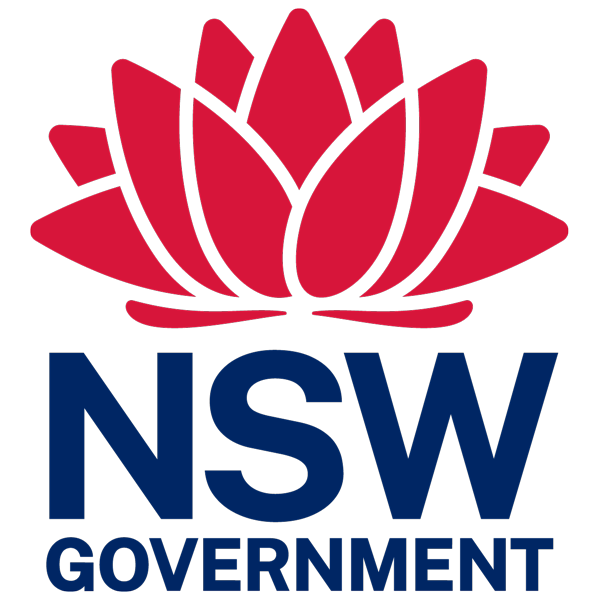

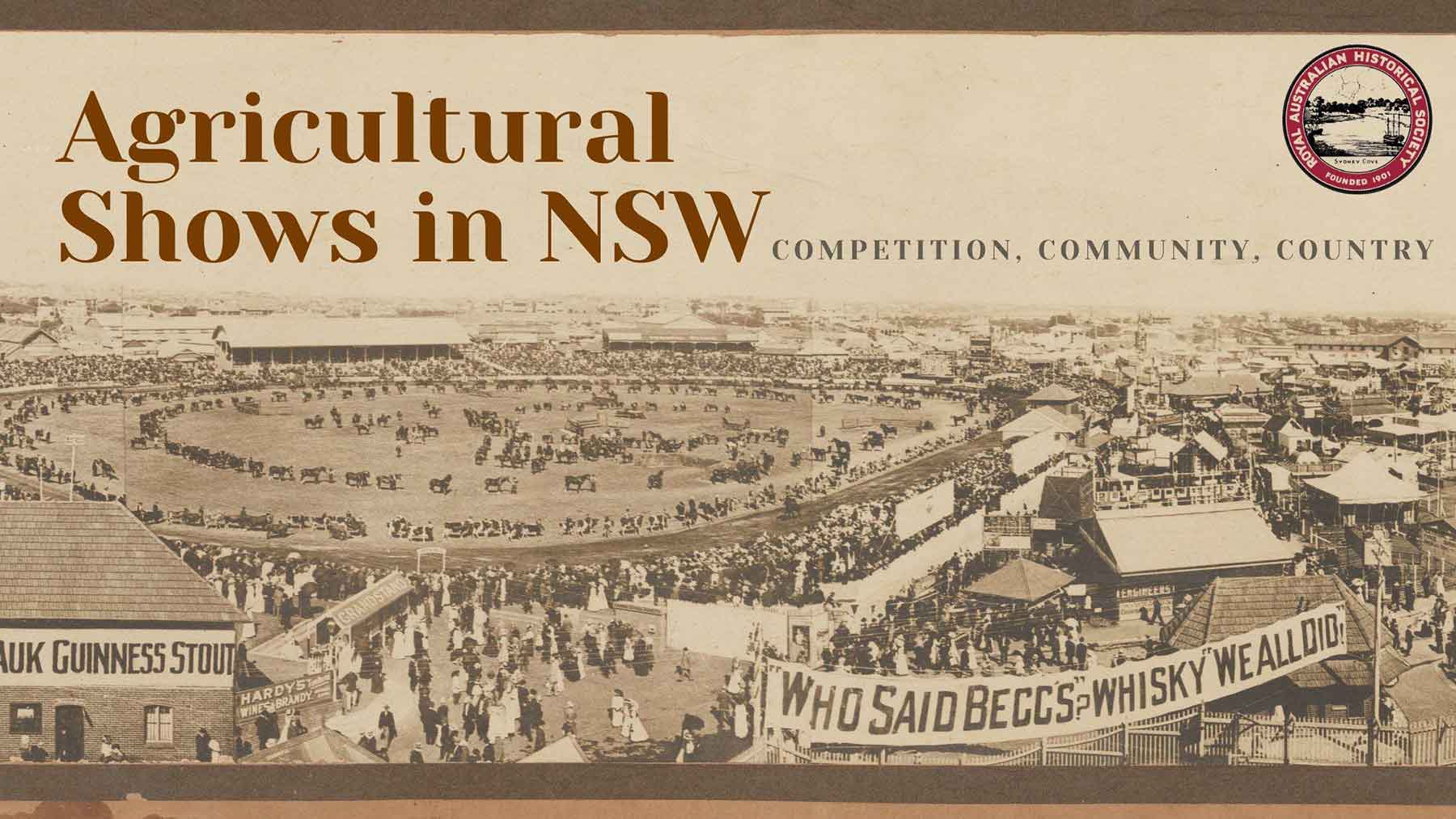

![Exhibition Building, Prince Alfred Park [RAHS Photograph Collection]](https://www.rahs.org.au/wp-content/uploads/2022/12/Exhibition-Building-Prince-Alfred-Park-1800-1080px.jpg)
![Pegasus-Elliot Bros van at Sydney Showground, c.1908 [RAHS Photograph Collection]](https://www.rahs.org.au/wp-content/uploads/2022/12/Pegasus-van-at-Showground-accordion-version1800x1080px.jpg)
![Peters Ice Cream Float, 1938 [RAHS Photograph Collection]](https://www.rahs.org.au/wp-content/uploads/2022/12/peters-Ice-cream1800x1080px.jpg)
![Agricultural Ground, 1896 [RAHS Glass Slide Collection]](https://www.rahs.org.au/wp-content/uploads/2022/12/PWG-356-showground-1896-1800x1080px.jpg)
![Sydney Showground, small rings, Easter 1936 [RAHS Adastra Collection]](https://www.rahs.org.au/wp-content/uploads/2022/12/Showground-small-rings-Easter-1936-RAHS-1800x1080px.jpg)
![Sydney Showground, Grand Easter Parade, 1936 [RAHS Adastra Collection]](https://www.rahs.org.au/wp-content/uploads/2022/12/Showground-Grand-Parade-Easter-1936-RAHS-1800x1080px.jpg)